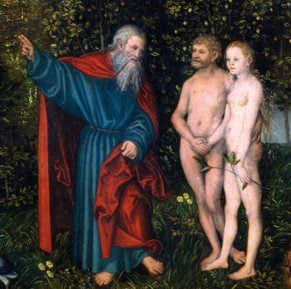 The next chapter of John Walton’s recent book The Lost World of Adam and Eve: Genesis 2-3 and the Human Origins Debate digs into the question of Paul’s use of Adam, particularly in Romans, but also in 1 Corinthians. Because he is an Old Testament scholar he brought in a New Testament scholar (and one who has written extensively on Paul) – N. T. Wright. Most of this chapter was written by Wright.
The next chapter of John Walton’s recent book The Lost World of Adam and Eve: Genesis 2-3 and the Human Origins Debate digs into the question of Paul’s use of Adam, particularly in Romans, but also in 1 Corinthians. Because he is an Old Testament scholar he brought in a New Testament scholar (and one who has written extensively on Paul) – N. T. Wright. Most of this chapter was written by Wright.
First, Walton suggests that we should focus on Paul’s use of Adam and not get sidetracked by such questions as “Does Paul believe in a historical Adam?”
The modern questions and traditional readings can easily lead us off track if they are not focused on the actual case that Paul is building. It is important for us to set aside our modern questions and traditional interpretations and focus on what Paul is doing as he makes his points. (p. 170)
The traditional interpretations may not be correct and our modern questions may not be important. If the traditional interpretations are correct, focusing on the actual case that Paul is building will lead us back to these interpretation. If they are not correct, well shouldn’t we be seeking the best interpretation?
What is the focus of Paul’s Argument? N. T. Wright develops a sketch of the argument: The importance of Adam is in his vocation as God’s image bearer in the world.
[Paul] didn’t start with a Jewish theory of “the fall of Adam” because such a theory did not exist. His reflections are prompted by a different apparent tragedy, but one that then turned to triumph: the crucifixion of Israel’s Messiah and his resurrection from the dead. The problems of which Saul of Tarsus was aware in his early life – the problems, political and theological, caused by Roman oppression and by Jewish failure to keep Torah properly – were revealed, by the Messiah’s cross to be much deeper than he had imagined. If a crucified Messiah was the divine answer to the problem, the problem must have been far worse than he had thought. (p. 171)
But now Paul sees that the Psalm 8 glory that God intended for humankind is being fulfilled in Jesus and shared with those who are in Christ, that is, “in the Messiah.” The best way to lay out the argument is to quote Wright:
It is important to be clear about this wider context because the question generated by the scientific study of cosmic and human origins (“did Adam exist?” or “was their an original Adam?) has become muddled up with the soteriological question, as to whether an “original Adam” is necessary for a biblical doctrine of salvation. But this would-be biblical doctrine has often been presented in a shrunken and distorted way. (p. 172)
Wright, by the way, does hold to a historical Adam on other grounds, but thinks that we’ve muddled up this discussion by tying it to a truncated doctrine of salvation. In Wright’s view, much like Walton’s, Adam and Eve are a pair chosen from the group for a special calling and vocation, in which they failed. But to continue with the main point:
What is more important for our present brief purposes is to note the very different (and deeply biblical) story about Adam that Paul tells. As in Genesis, where the new start in Genesis 12 represents the divine answer to the problem of Genesis 3-11, in Paul’s exposition the divine answer to the problem of Adam (here at Rom 1:18-3:20) is the call of Abraham and the establishment of the covenant with him (here at Rom 4). For Paul, what God has done in and through Jesus the Messiah and his faithful death is to be true to the covenant with Abraham, and therefore to deal with the sin of Adam and its effects. That is what Paul then sums up in Romans 5:12-21, and explains more fully in Romans 6-8. (p. 172-173)
Paul does not skip from Adam to Jesus and neither should we. Genesis 12 through Malachi 4 are indispensable.
First, Paul’s exposition of Adam in these passages is explicitly in the service, not of a traditional soteriology but of the kingdom of God. Second, there is a close parallel between the biblical vocation of Adam in Genesis and the biblical vocation of Israel, and when we explore this we may find fresh ways to the heart of some contemporary puzzles. (p. 173)
With respect to Adam and the kingdom of God. Adam’s sin meant that he lost the reign over the world and it is Jesus who is the obedient human at the helm. This isn’t a theological explanation of the mechanism of personal salvation, but the manner in which God is putting all of creation to right. “God sets people right in order that through them he will set the world right. Justification by faith is God putting people right in advance, in order that through them God will put the world right.” (p. 174) The point isn’t Adam, but Adam’s vocation.
Paul’s whole point is to pick up from Genesis the notion of the vocation of Adam and to show that it is being fulfilled in the Messiah. Unless we put that in the middle, we are not being obedient to the authority of these central scriptural texts. (p. 175)
Adam was called to reflect God’s wise order in the world, to be a royal priesthood – royal ruling, and priestly praising.
Genesis, the Gospels, Romans and Revelation all insist that the problem goes like this: human sin has blocked God’s purposes for the whole creation; but God hasn’t gone back on his creational purpose, which was and is to work in his creation through human beings, his image-bearers. In his true image-bearer, Jesus the Messiah, he has rescued humans from their sin and death in order to reinscribe his original purposes, which include the extension of sacred space into all creation, until the earth is indeed full of God’s knowledge and glory as the waters cover the sea. (p. 176)
Yes! Except that it seems to me that God, as God, knew that his purposes would require incarnation … It is and always was going to be necessary for, as John says, the Word to be come flesh and dwell among us. As Isaiah makes explicit – the Lord Almighty is the redeemer of Israel, and now Paul sees, the redeemer of both Jew and Gentile.
With respect to the vocations of Adam and Israel. Wright, along with Walton and many others, sees a strong parallel between the calling and vocation of Adam and the calling and vocation of Israel. Like Adam, Israel is to be God’s image-bearer and a royal priesthood. But Israel is “in Adam” and fails. “Certainly the Jews of the Second Temple period would have no difficulty in decoding the story of Adam as an earlier version of their own story.” (p. 177) Because of this parallel Wright sees it as highly plausible that God chose Adam and Eve out of a larger population as a special pair for a special vocation as he chose Israel out of many nations and peoples for a special vocation.
The focus of Paul isn’t Adam or Israel, but Christ.
Look at Paul’s language: Jesus is the beginning, the firstfruits, the true Image, the Temple in whom God’s fullness was pleased to dwell. He is Israel’s Messiah, who fulfills Israel’s obedience on the cross and thereby rescues both Israel and the whole human race. He does for Israel what Israel couldn’t do for itself, and thereby does for humans what Israel was supposed to do for them, and thereby launches God’s project of new creation, the new world over which he already reigns as king. This is the great narrative, the true Pauline Adam-and-Christ story, and we need to learn how to tell it and live it. (p. 179)
The Adam-Christ story isn’t how we get saved and solve an original sin problem – but how “we are rescued by the blood of the Lamb in order to be a royal priesthood.” (p. 180) This isn’t all sunshine and light – for it calls us in the way of Jesus to take up our cross and suffer with him as well. But it is God’s plan for the world and for New Creation.
The traditional view of Adam-Christ soteriology is, Wright suggests, a pale shadow and a distortion of the full story.
If it is Adam’s vocation that is important, our focus on Adam should be on his vocation and calling. This could be as the first man (although the science makes this hard to argue convincingly), the first “spiritual man” (Denis Alexander’s suggestion of homo divinus), a federal representative (John Stott’s commentary on Romans) or an archetypal representative as Walton argued earlier in the book. It could be a group of humans as C.S. Lewis suggests in The Problem of Pain. It could even be a literary Adam representing a vocational calling and failing of mankind. I will suggest that nothing of importance in Paul’s argument in Romans and 1 Corinthians hangs on the specific view of Adam as original progenitor, representative, or literary. (Although I realize that many disagree – and it is worth ongoing conversation. I’m always open to compelling arguments.)
Where would you take issue with Wright’s argument?
In what way does Adam matter to Paul’s argument? Is it his body (and seed) that is significant or his vocation?
Is the story of Adam parallel to the story of Israel?
If you wish to contact me directly you may do so at rjs4mail[at]att.net
If interested you can subscribe to a full text feed of my posts at Musings on Science and Theology.














